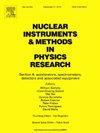The CMS barrel timing layer: test beam confirmation of module timing performance
IF 1.4
3区 物理与天体物理
Q3 INSTRUMENTS & INSTRUMENTATION
Nuclear Instruments & Methods in Physics Research Section A-accelerators Spectrometers Detectors and Associated Equipment
Pub Date : 2025-07-19
DOI:10.1016/j.nima.2025.170823
引用次数: 0
Abstract
First of its kind, the barrel section of the MIP Timing Detector is a large area timing detector based on LYSO:Ce crystals and SiPMs which are required to operate in an unprecedentedly harsh radiation environment (up to an integrated fluence of 1 MeV ). It is designed as a key element of the upgrade of the existing CMS detector to provide a time resolution for minimum ionizing particles in the range between 30–60 ps throughout the entire operation at the High Luminosity LHC. A thorough optimization of its components has led to the final detector module layout which exploits 25 m cell size SiPMs and 3.75 mm thick crystals. This design achieved the target performance in a series of test beam campaigns. In this paper we present test beam results which demonstrate the desired performance of detector modules in terms of radiation tolerance, time resolution and response uniformity.
CMS筒体授时层:测试波束确认模块授时性能
首先,MIP定时探测器的筒体部分是基于LYSO:Ce晶体和SiPMs的大面积定时探测器,需要在前所未有的恶劣辐射环境中工作(高达2×1014 1 MeV neq/cm2的综合影响)。它被设计为现有CMS探测器升级的关键元素,在高亮度LHC的整个运行过程中提供30 - 60ps范围内的最小电离粒子的时间分辨率。对其组件进行了彻底优化,最终的探测器模块布局利用了25 μm单元尺寸的sipm和3.75 mm厚的晶体。该设计在一系列测试梁运动中达到了目标性能。在本文中,我们给出了测试光束结果,证明了探测器模块在辐射容限,时间分辨率和响应均匀性方面的理想性能。
本文章由计算机程序翻译,如有差异,请以英文原文为准。
求助全文
约1分钟内获得全文
求助全文
来源期刊
CiteScore
3.20
自引率
21.40%
发文量
787
审稿时长
1 months
期刊介绍:
Section A of Nuclear Instruments and Methods in Physics Research publishes papers on design, manufacturing and performance of scientific instruments with an emphasis on large scale facilities. This includes the development of particle accelerators, ion sources, beam transport systems and target arrangements as well as the use of secondary phenomena such as synchrotron radiation and free electron lasers. It also includes all types of instrumentation for the detection and spectrometry of radiations from high energy processes and nuclear decays, as well as instrumentation for experiments at nuclear reactors. Specialized electronics for nuclear and other types of spectrometry as well as computerization of measurements and control systems in this area also find their place in the A section.
Theoretical as well as experimental papers are accepted.

 求助内容:
求助内容: 应助结果提醒方式:
应助结果提醒方式:


